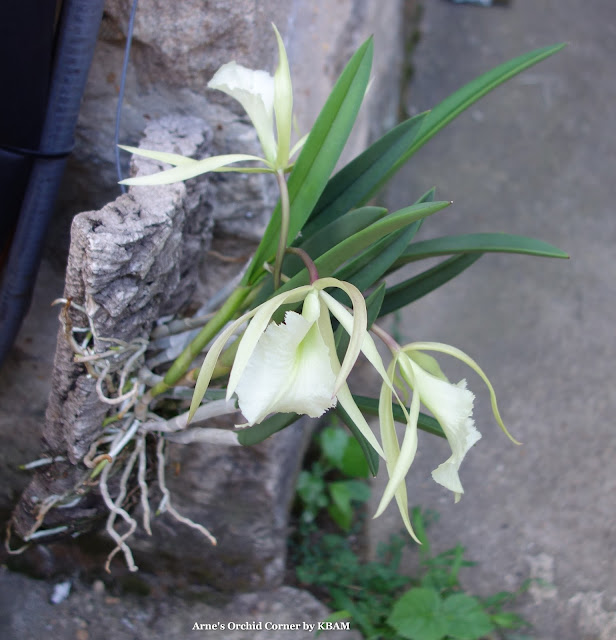 |
Laelia gouldiana
|
As this is one of our newer orchids, Arne had put the following paragraph together as a brief introduction to this Mexican beauty.
Laelia gouldiana
is a true Laelia from Mexico. Laelia
used to be a genus with species in Mexico and tropical South America, mainly
Brazil. Nowadays, only the species in
Mexico are considered Laelias while all the species in Brazil are considered Cattleyas.
Laelia
gouldiana is a delightful orchid that is relatively easy to grow (it is
very easy to grow where the climate is Mediterranean). I give it a lot of water from the time it
puts out new growths in spring until the flowers have developed in late
fall. While in active growth it needs
bright light and temperatures in the range 68 – 85 °F (20 – 30 °C). It does not like hot Baltimore summers so I
let it grow under lights in the basement until it cools down in late August
when I put it outside where it can develop its tall flower stems. It needs a lot of space then! Winters should be on the cooler side when the
plants should receive almost no water at all.
By Arne Schon
 |
| A) As the temperature hits up, we began to take our orchid out to enjoy the sun in August. |
 |
| B) The flower stem began shooting upwards and we see signs of flower buds in the tip. |
 |
| C) By September, the single stem was more than 12 inches in height and we can see the developing buds. |
 |
| D) Developing buds. |
 |
| E) By October 16, two of the flowers were in full bloom. We still had six or more buds waiting. |
 |
| F) The beauty of each flower in the sun. |
 |
| G) By November 6, the two flowers (in E & F) had wilted but almost all of the remaining buds were opened. We needed a flower stake at this time to hold the flower ladened stem stable. |
 |
| H.1 |
 |
| H.2 |
 |
| H.3 |
In photos H.1, H.2 and H.3, I tried to figure out if I can see how many flowers we had. It looked like, on November 6, we still had one more bud still waiting to open.
Today, I can confirm that our Laelia gouldiana had a total of ten flowers. Quite impressive for our first time. The height of the flower stem is definitely more than 2 feet tall! Our specimen is now sitting indoors by our study window as it is getting cold here in Baltimore. We are getting frost each morning and the Fall is definitely here! Until the next flowering cycle then!
It has been a strange and difficult week for us in this country. I just need to say that I believe there is still a lot of goodness here. Thanks for reading my post today. Until next time, keep the faith and be safe.


















































